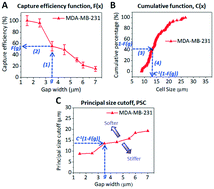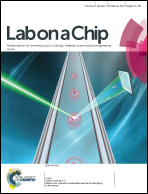Evaluating a novel dimensional reduction approach for mechanical fractionation of cells using a tandem flexible micro spring array (tFMSA)†
Abstract
We present a novel methodology to establish experimental models for the rational design of cell fractionation based on physical properties of cells. Label-free microfluidic separation of cells based on size is a widely employed technique. However, close observation reveals that cell capture results cannot be explained by cell sizes alone. This is particularly apparent with viable cell fractionation, where cells retain their native deformability. We have developed a principal size cutoff (PSC) model based on the analysis of size distribution and size-based filtration efficiency for cell populations. The goal of this analysis is to use an unbiased approach to achieve dimensional reduction of deformability and other mechanical properties that affect cell capture. The PSC model provides a single calibrated principal size component that may be compared directly to device gap width, which is the critical dimension for cell filtration. The PSC model was evaluated experimentally using a tandem flexible micro spring array (tFMSA) device made of parylene filtration elements applied within micro-molded polydimethylsiloxane (PDMS) chambers. In the tFMSA device, a mixture of cells is sequentially passed through individual filters with decreasing gap widths to allow size-based selection. We applied this method to demonstrate viable separation of subgroups of cells with different mechanical properties from complex mixtures, including fractionation according to cancer cell type, cell cycle stage, cell viability status, and leukocyte nuclear phenotype. The PSC methodology and tFMSA device can advance a better understanding of complex factors affecting mechanical cell fractionation and provide a miniature platform for obtaining rationally designed cell fractions for biomedical applications.



 Please wait while we load your content...
Please wait while we load your content...